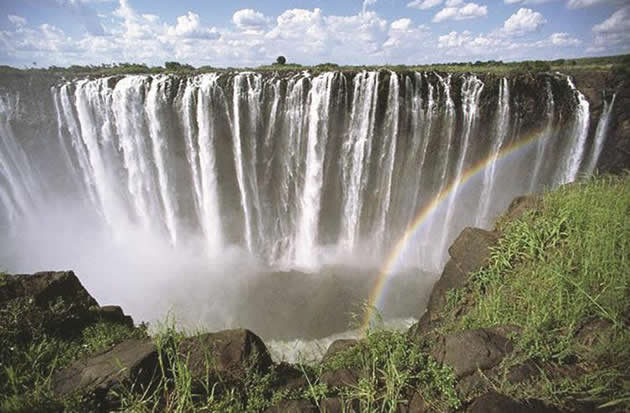Can tourism sector steer Zim-Asset?

 Anna Chingarande and Felix Chari
Anna Chingarande and Felix Chari
TOURISM is the fastest growing sector world-wide. It is also the sector that is the most vulnerable to political disturbances. Political disturbances have affected tourism growth in Egypt, Iraq, Afghanistan, Syria, Mali and other countries. In Zimbabwe, tourism ranks fourth in its contribution towards the country’s earnings and contributes 10 percent to the Gross Domestic Product (GDP).
The Zimbabwe Agenda for Sustainable Socio-Economic Transformation (Zim-Asset) is a government macro-economic programme launched in October 2013 and will run up to December 2018. The programme is divided into four clusters namely: Food Security and Nutrition; Social Services and Poverty Eradication; Infrastructure and Utilities; and Value Addition and Beneficiation.
The programme aims at rapid economic growth and creation of wealth through indigenisation, empowerment and employment creation based on utilisation of Zimbabwe’s human and natural resources, according to the government. The objective of this write-up is to explore whether tourism can steer Zim-Asset.
Zimbabwe experienced economic downturn from 2001 to 2008. A positive economic growth to the tune of 4.7percent was reached in 2009 signifying recovery. However, such recovery cannot be sustainable for a long period without the government implementing deeper reforms, the African Development Bank said in 2010. To answer or deal with the objective of this write-up, the starting point is to look at the tourism sector in Zimbabwe.
The tourism sector grew steadily at independence in 1980 owing to the removal of sanctions imposed on Rhodesia then by the United Nations. With the new legitimate government in place, the number of visitors coming to Zimbabwe grew. The period 1980 to 1999 saw a remarkable growth in the sector.
However in 2000, the war veterans’ occupation of white commercial farms and subsequent formalisation of it by the government was seen as marking of intensive land reform programme. This angered countries and organisations such as the United Kingdom, the United States, Canada, Australia and the European Union. The anger was followed by measures or travel bans imposed on Zimbabwe’s political leadership. These measures were subsequently expanded to full sanctions such as the Zimbabwe Democracy and Economic Recovery Act (ZIDERA) of 2001 by the United States of America Congress.
The Act prevented the Secretary of Treasury and USA Directors in Multilateral Organisation such as the World Bank, and International Monetary Fund from extending credit to Zimbabwe. The Act was replaced with Zimbabwe Transition and Economic Recovery Act 2010 and allowed some assistance to some ministries then not controlled by Zanu-PF in the inclusive government and the Parliament of Zimbabwe.
However the major tenets of both Acts still remain intact and Zimbabwe has been unable to secure credit needed to modernise facilities in this sector and others. The impact of the sanctions has resulted in a fluctuation in the tourism sector just like other sections in Zimbabwe experienced. The fluctuation in tourism was mainly due to bad publicity of Zimbabwe by international media especially in the western countries that imposed sanctions on Zimbabwe. The tourism sector is quite sensitive and responds immediately to travel bans and warnings especially by countries such as the United States of America. The USA State Department is known for issuing travelling warnings to its citizens. Such warnings are taken as a cue if the security situation in a country named in the bulletin.
Zimbabwe’s hopes to revive the sector was hinged on the hosting of Fifa World Cup by South Africa in 2010. There was hope that visitors coming to watch the game in South Africa would find their way to Zimbabwe before or after the World Cup. South Africa had given the impression to its neighbours that they too would benefit from the World Cup through tourism without putting in place a mechanism that would help the neighbouring countries benefit through tourism. Zimbabwe’s tourism stakeholders and individuals embarked on infrastructure renovation and development in readiness of the FifaWorld Cup 2010. The World Cup was seen as an opportunity in Zimbabwe to increase on bed occupation rates in Zimbabwe.
However, despite the readiness by Zimbabwe, its main predicament was inefficiency of the national airline which was experiencing operational challenges arising from many factors. In order for Zimbabwe to benefit from the Fifa World Cup 2010, there was to be very efficient air transport which would have allowed a number of aircraft operating between Zimbabwe and South Africa for short intervals. That could have allowed visitors to the Fifa World Cup 2010 opting to stay in Zimbabwe while commuting to the matches in South Africa. Zimbabwe should have come up with such a package and advertised it internationally. In the absence of such a package and failure by South Africa to accord some official tasks to its neighbours such as Zimbabwe led to such countries not benefitting from the millions of visitors who visited South Africa. However, South Africans cannot be entirely blamed as they wanted to maximise the facilities they had built which now stand as white elephants. The one off income was necessary to compensate the overall costs of hosting such a tournament.
In August 2013, Zimbabwe and Zambia co-hosted the United Nations World Tourism Organisation (UNTWO) General Assembly. According to government this was an affirmation and endorsement that Zimbabwe is a safe place for tourists. Zimbabwe proudly has one of the Seven Wonders of the World, the Victoria Falls. The Victoria Falls is one of the wonders declared by Unesco as a World Heritage. Besides Victoria Falls, Zimbabwe also has other attractions such as the Great Zimbabwe, Nyanga National Park, Hwange National Park and Lake Kariba. Lake Kariba is one of the world’s the largest man-made lakes. The Victoria Falls are the largest falls in the world.
Tourism falls under the fourth cluster of ZimAsset (i.e Value Addition and Beneficiation) and is expected it is going to contribute significantly towards the transformation of the social-economic development of Zimbabwe.
In this paper, the authors use historical approach to trace the growth of tourism in Zimbabwe. The data used in this paper was obtained from the Zimbabwe Tourism Authority (ZTA). The data used is secondary, the most preferred data in economics.
Results and analysis
Table 1 below shows tourist arrivals in Zimbabwe.
Year Arrivals in Zimbabwe
1995 1,363,412
1996 1,577,005
1997 1,281,205
1998 1,986,474
1999 2,249,615
2000 1,966,582
2001 2,217,429
2002 2,041,202
2003 2,256,205
2004 1,854,488
2005 1,558,501
2006 2,286,572
2007 2,513,204
2008 1,956,442
2009 2,017,264
2010 2,239,165
2011 2,423,280
2012 1,794,230
In Table 1 above, taking 1995 as a base year, in 1996 tourist arrivals increased by 15.7 percent. In 1997 however tourist arrivals fell by -7.9 percent. In 1998 tourist arrivals picked up by 45.5 percent. The arrivals further increased by 64.9% in 1999. In 2000 there was an increase but was less than that of 1999 at 44 percent. In 2001 tourist arrivals in Zimbabwe soared to 62.6 percent before only increasing by 49.7 percenet in 2002 then picking up 65.4 percent in 2003. Then in 2004 tourist arrivals increased only by 36 percent. In 2005 the increase was marginal at 14.3 percent. In 2006 there was substantial increase in tourist arrivals in Zimbabwe by 67.7 percent. Then the increase soared by 84 percent in 2007. In 2008, the increase in tourist arrivals in Zimbabwe was only 43 percent. In 2009 the increase was 47.2 percent. In 2010 the tourist arrivals in Zimbabwe increased by 64.2 percent. In 2011, Zimbabwe recorded an increase of 77.8 percent while in 2012 the increase amounted to 31.6 percent. Since 1995, the increase has been fluctuating rather than steady.
Figure 1 shows tourist arrivals by region in 2012 in Zimbabwe.
In Figure 1, the highest tourist arrivals came from within Africa accounting for 1,562,622. In second place was Europe accounting for 111,529. In third place was America accounting for 58, 873. In fourth place was Asia accounting for 36,499 tourist arrivals. In fifth place is Oceania accounting for 21,493.
In sixth place was the Middle East accounting for only 3,214.
Figure 2 shows top 12 countries which contributed to tourist arrivals in Zimbabwe in 2012.
In Figure 2, the highest contributor to tourist arrivals in Zimbabwe in 2012 was South Africa accounting for 719,637. It was followed by Zambia accounting for 278,856. In third place was Malawi accounting for 241, 344. In fourth place was Mozambique accounting for 146, 922. It was followed by Botswana with 64,926. In sixth position was the USA accounting for 50,060. In the seventh position was Britain and Ireland accounting for 27,987.
Eighth was DR Congo accounting for 23,584. On ninth position was Lesotho accounting for 20,051. In tenth position was Japan accounting for 18,052. In the eleventh place was Tanzania accounting for 14,740. In the twelfth place was Australia accounting for 13,355.
The Southern African countries are leading in contributing to tourist arrivals due to the fact that the countries are close to Zimbabwe making the cost of travelling affordable. Further under the Southern African Development Community (Sadc) arrangement member states have removed visa requirements in the region making travelling within the region much easier. Other regions are slower in contribution because of hassles in securing visas. The government figures show that the Western countries are the biggest spenders followed by the Asians. The Africans are smaller spenders although they contribute much more in numbers.
The conclusion is that the tourism sector has potential to contribute to Zim-Asset provided there are significant interventions to make the sector very robust. There is also lack of appropriate promotion in the high spending countries in places such as the Victoria Falls.
It is recommended that government considers streamlining visa requirements to enable the tourist to come to Zimbabwe easier. It may be necessary for some potential to remove the visa requirement altogether. It is further recommended that the Zimbabwe Tourism Authority (ZTA) should use other modes of promoting tourism in Zimbabwe such as advertising of places like the Victoria Falls on channels such as CNN and Sky News. Such channels are watched in many heavy spending countries and there are other Tourism Promotion Agencies that advertise their countries as destination.
- Anna Chingarande and Felix Chari are lecturers in the Economics Department at Bindura University of Science Education. They can be contacted at [email protected] and [email protected]










Comments